Kanji for “Gold” and “Money”: 金 (kin / kane)
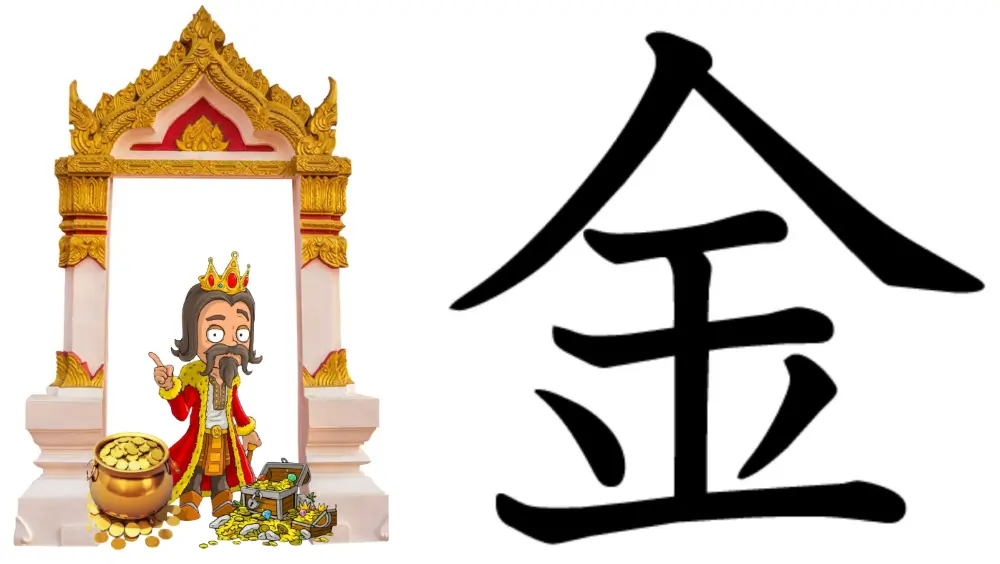
The Japanese Kanji for “Gold” is 金. Moreover, because of the historical and practical associations between the precious metal (Gold) and monetary systems, the Kanji 金 also means “money.” However, the primary meaning of 金 is “metal” in general though it denotes the metal gold more specifically.
The kun’yomi (Japanese reading) pronunciations of the Kanji 金 are “kane” (かね) and “kana” (かな), and the on’yomi (Chinese reading) pronunciations of 金 are “kon” (コン), and “kin” (キン).
The Kanji 金 commonly appears in Japanese names and is used in 311 names. However, in names, it is pronounced as “Kan” (かん), “kimu” (きむ), “ko” (こ), “kono” (この), or “n” (ん).
The Kanji 金 is constructed with 8 strokes. It is part of the JLPT N3 syllabus (please check the list of JLPT N5 Kanji), and it is taught in grade 1 in Japanese schools.
Origin of the Shape 金
The following illustration shows the ancient shapes of the kanji 金 and how we write it today:
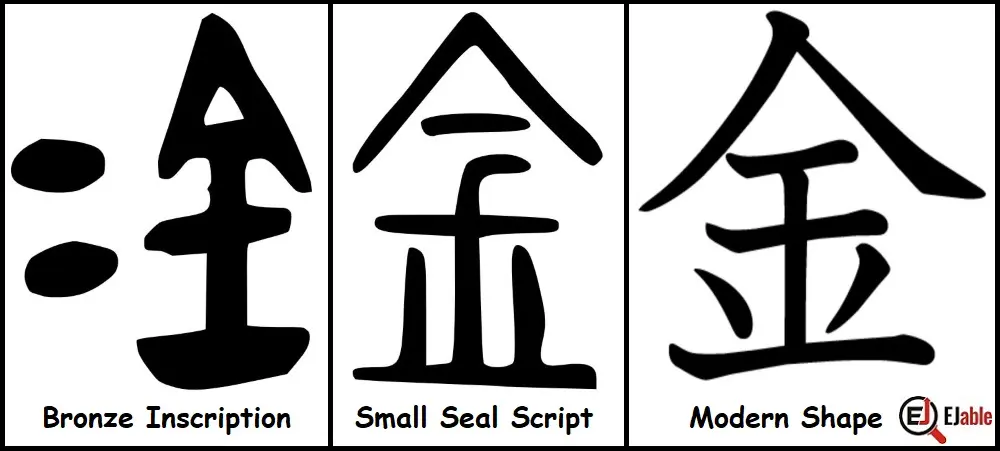

The above illustration shows the evolution of the shape of this Kanji from Bronze inscription through the small seal script to its modern shape.
It is believed that the upper portion of the ancient Kanji 金 finds its origin in the shape 今 and is used for phonetic purposes for its same Chinese pronunciation as “kin” (キン), and the lower part 土 denotes earth or soil with metal nuggets. This interpretation makes good sense because it associates this Kanji with the mining of metals.
Components and Construction of the Kanji 金
The Kanji 金, which in essence means “metal” but is used more specifically for “gold,” is constructed with three components 𠆢, 王, and 丷. Please also check the Kanji for “whole” or “all” (王) for the mentioned first two components.
Radical 𠆢
The component 𠆢 (hitoyane /人屋根) means person and roof. However, consider it just as a roof radical in the Kanji 金.
Component 王
王 is the Kanji for King. For ready reference, please check the following illustration of an axe of the king, or the power of the king, as a mnemonic for 王:
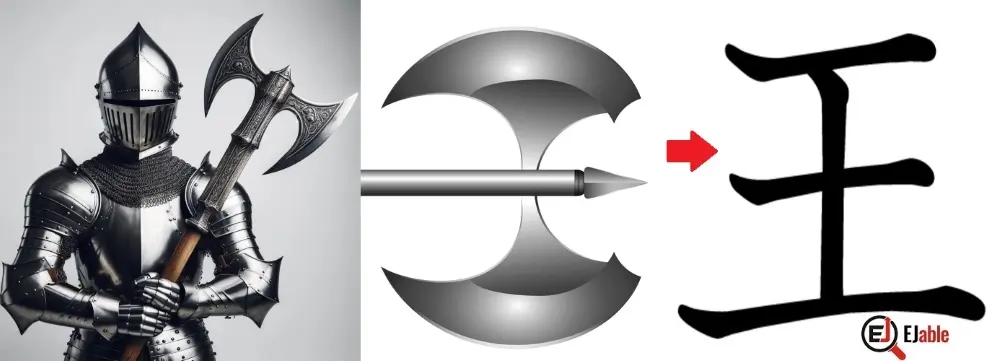

The Two Dashes 丷
丷 is a Kanji radical meaning grass, plant, or horns. However, in the Kanji 金, the two dashes are separated, and hence, the two dashes do not represent the radical 丷.
In the old shape of 金, the dashes represented metal or gold nuggets in the earth. We can consider them to mean the same in the modern share ((shinjitai); however, please note that many Kanji characters use components that do not necessarily have a meaning. These components are often used to make a Kanji recognizable and distinct from others with similar elements. Sometimes they are also used for structural or visual balance.
Mnemonic to Remember the Kanji 金’s Meaning as “Gold”
The above-mentioned logic can very well help in remembering the shape 金 to mean gold.
However, the following illustrations can make good pictorial mnemonics to relate the shape 金 to associate it with “gold”:
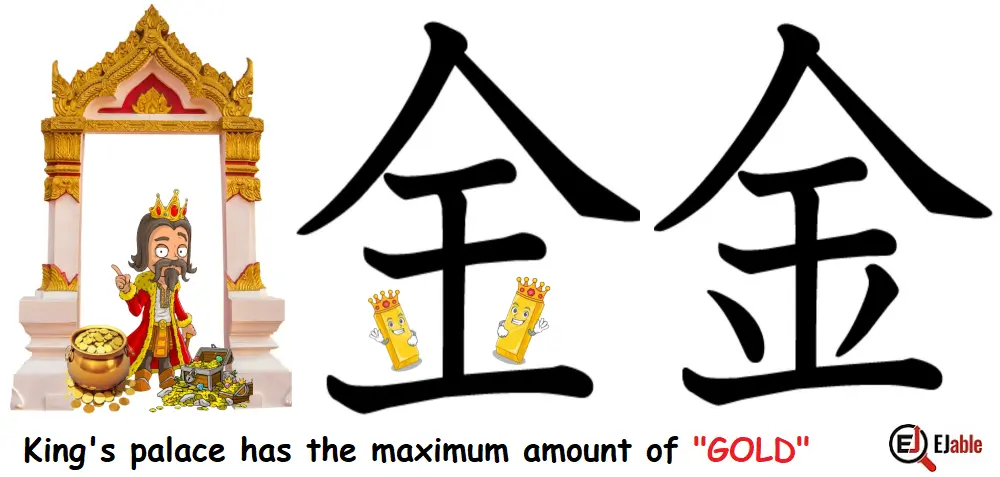

Explanation
Consider the roof (𠆢) over the king’s kanji (王) to denote the palace of the king. And in the old days, where would you find the maximum gold? of course, in the king’s place. The above illustration helps in associating the shape of 金 to this logic.
Stroke Order for the Kanji 金
The following illustrations show the order of the 8 strokes to write the Kanji 金:
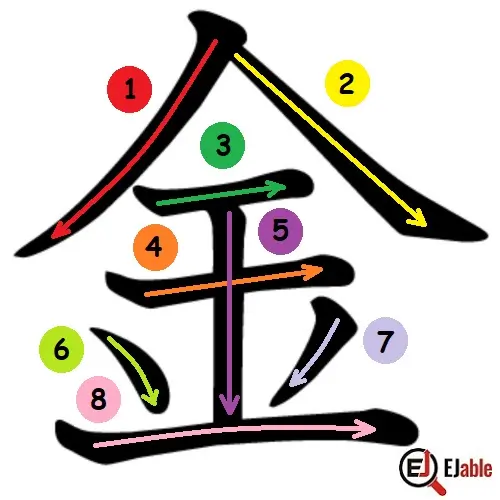

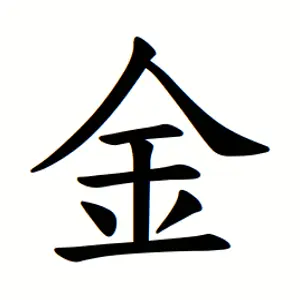

金 as a Component in other Kanji Characters
The Kanji 金 is used as a component in 176 Kanji characters, out of which 31 are Jōyō (commonly used) Kanji. However, please note that, in general, 金 means metal, and therefore, many kanji characters using 金 as a part are not related to gold specifically.
Following are some of the examples of such Jōyō kanji which use gold’s kanji as a component or radical:
- 銀 (ぎん / gin): Silver.
- Explanation: Refers to the metal silver, often used in contexts related to currency and jewelry.
- 鉄 (てつ / tetsu): Iron.
- Explanation: Represents iron, emphasizing the metal’s strength and utility in construction and tools.
- 銭 (せん / sen): Coin, money.
- Explanation: Historically used to refer to small denominations of currency, like coins.
- 銅 (どう / dō): Copper.
- Explanation: Indicates copper, known for its conductivity and use in electrical and thermal applications.
- 録 (ろく / roku): Record.
- Explanation: Symbolizes recording or documenting, often in an official capacity.
- 鋼 (こう / kō): Steel.
- Explanation: Denotes steel, highlighting the alloy’s strength and significance in various industries.
- 鏡 (きょう / kyō): Mirror.
- Explanation: Refers to a mirror, traditionally made with polished metal surfaces.
- 錠 (じょう / jō): Lock, tablet.
- Explanation: Used for locks or small molded objects like tablets (of medicine).
- 鋭 (えい / ei): Sharp.
- Explanation: Means sharp, as in the sharpness of a metal blade.
- 銃 (じゅう / jū): Gun.
- Explanation: Refers to a gun, focusing on metal firearms.
- 鉛 (えん / en): Lead.
- Explanation: Indicates lead, a heavy metal known for its malleability and toxicity.
- 鍛 (たん / tan): Forge, temper.
- Explanation: Used to describe the process of forging or tempering metals.
- 錯 (さく / saku): Confused, mix.
- Explanation: Can imply mixing or confusion, often used in chemical or abstract contexts.
- 鍵 (かぎ / kagi): Key.
- Explanation: Refers to a key, typically made of metal, used for locking or unlocking.
- 鎖 (さ / sa): Chain.
- Explanation: Denotes a chain, emphasizing links made of metal.
- 鎮 (ちん / chin): Quell, calm.
- Explanation: Used in terms of calming or stabilizing, metaphorically as heavy metal calms by its weight.
- 鍋 (なべ / nabe): Pot.
- Explanation: Refers to a cooking pot commonly made of metal.
- 鑑 (かん / kan): Criterion, model.
- Explanation: Implies a model or standard, often used in the sense of appraisal or reflection, like a mirror.
- 鋲 (びょう / byō):- Rivet.
- Explanation: Refers to a rivet, a short metal pin or bolt used for holding together pieces of metal.
- 鍔 (つば / tsuba): Sword guard.
- Explanation: The guard against a sword means the metal component that protects the hands.
These examples showcase how 金, as a radical, imbues Kanji with meanings connected to metal’s properties—such as durability, conductivity, and value—or to objects typically made from metals. As mentioned above, please treat 金 as the kanji for metal and not specifically gold in any other kanji characters.
金 Kanji in Compounded Words
There are 482 Japanese words that begin with the Kanji for “gold” (金), and it appears in 1256 words overall.
Examples of Kanji 金 in Compounded Japanese Words
- 金額 (きんがく / kingaku): Amount of money— refers to a sum of money.
- 金属 (きんぞく / kinzoku): Metal— a general term for any type of metal.
- 金庫 (きんこ / kinko): Safe— a secure storage unit for money or valuables.
- 金融 (きんゆう / kinyū): Finance— relating to the management of money, especially on a large scale.
- 金曜日 (きんようび / kinyōbi): Friday—; the day of the week associated with the planet Venus (金星, kinsei), which symbolizes beauty and gold.
- 金魚 (きんぎょ / kingyo): Goldfish— a common pet fish, named for its golden color.
- 金子 (かねこ / kaneko): Gold coin— also a common Japanese surname.
- 金網 (かなあみ / kanaami): Wire netting— a mesh made typically of metal wire.
- 金具 (かなぐ / kanagu): Metal fitting— hardware used for mechanical or construction purposes.
- 金星 (きんせい / kinsei): Venus— the planet, also called the “gold star.”
- 金持ち (かねもち / kanemochi): Wealthy person— someone who possesses a lot of money.
- 金券 (きんけん / kinken): Gift certificate, i.e., a voucher that can be exchanged for goods or services, often representing monetary value.
- 金利 (きんり / kinri): Interest rate— the percentage charged on money lent or borrowed.
- 金銭 (きんせん / kinsen): Money— specifically coins or cash.
- 金髪 (きんぱつ / kinpatsu): Blond hair— literally “golden hair,” often used to describe people with naturally or dyed blonde hair.
- 金槌 (かなづち / kanazuchi): Hammer— a tool with a metal head, used for pounding.
- 金屏風 (きんびょうぶ / kinbyōbu): Gold folding screen— a decorative folding screen with gold leaf.
- 金縁 (きんべり / kinberi): Gold rim— an edge or border that is gilded or made of gold.
- 金歯 (きんば / kinba): Gold tooth— a dental crown or cap made of gold.
- 金言 (きんげん / kingen): Golden words— wise or valuable advice, akin to “golden” wisdom.
These examples show how the Kanji 金 is utilized in various expressions, indicating not only literal gold and metal but also figuratively representing value, durability, and monetary aspects in various forms of Japanese vocabulary.
Note: Check other Kanji characters on the page “How to Learn Kanji“.


A long-term ex-pat in Japan, Himanshu comes with an IT background in SAP consulting, IT Business Development, and then running the country operations of an IT consulting multinational. Himanshu is the co-founder and Managing Director of ReachExt K.K. and EJable.com. He is also an Advisory Board Member of a Silicon Valley AI/IoT startup.

